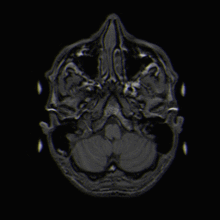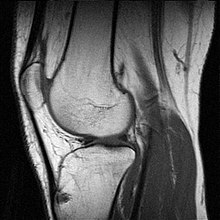Magnetic resonance imaging
Magnetic resonance imaging, abbreviated MRI or MR (as tomography from ancient Greek τομή tome, German 'Schnitt' and γράφειν graphein, German 'to write'), is an imaging technique used primarily in medical diagnostics to depict the structure and function of tissues and organs in the body. It is physically based on the principles of nuclear magnetic resonance (NMR), in particular field gradient NMR, and is therefore also called nuclear magnetic resonance imaging (colloquially sometimes shortened to Kernspin). The abbreviation MRI, which can also be found, comes from the English term Magnetic Resonance Imaging.
MRI can be used to produce cross-sectional images of the human (or animal) body, which allow an assessment of the organs and many pathological organ changes. It is based on very strong magnetic fields - generated in a magnetic resonance tomography system (abbreviation: magnetic resonance tomograph, MRT device) - as well as alternating magnetic fields in the radio frequency range, with which certain atomic nuclei (mostly the hydrogen nuclei/protons) in the body are resonantly excited, whereby an electrical signal is induced in a receiver circuit. Since the object to be observed thus "radiates itself", MRI is not subject to the physical law governing the resolving power of optical instruments, according to which the wavelength of the radiation used must be smaller the higher the required resolution. In MRI, object points in the submillimeter range can be resolved with wavelengths in the meter range (low-energy radio waves). The brightness of different tissue types in the image is determined by their relaxation times and the content of hydrogen atoms (proton density). Which of these parameters dominates the image contrast is influenced by the choice of pulse sequence.
No incriminating X-rays or other ionizing radiation is generated or used in the device. However, the effects of alternating magnetic fields on living tissue have not been fully researched.

Play media file MRI image of a human head in sagittal section plane

MRI slice images of a human brain (transverse plane), shown as a sequence from bottom to top.

Volume rendering of a head MRI

MRT device (Philips Achieva 3.0 T)

MRI image of a human knee joint, in sagittal slices
Methods and systems
Numerous special MRI techniques have been developed to provide not only the position and shape of organs but also information about their microstructure and function (especially their blood flow), for example:
- real-time MRI for the cinematic representation of moving joints or organs (e.g. heart),
- magnetic resonance angiography (MRA) for imaging the vessels,
- functional magnetic resonance imaging (fMRI) of the brain,
- perfusion MRI for the examination of tissue perfusion,
- diffusion or diffusion tensor imaging (DTI) for a virtual reconstruction of nerve fiber connections,
- MR elastography.
A distinction is made between closed MRI systems with a short or long tunnel and open MRI systems (oMRI) with a C-arm or laterally open tunnel. Closed tunnel systems provide comparatively better image data, whereas open MRI systems allow access to the patient under MRI control.
Another distinguishing criterion is the type of magnetic field generation. For weak magnetic fields up to approx. 0.5 Tesla flux density (magnetic induction), permanent magnets or conventional electromagnets are used, whereas superconducting magnetic coils are used for higher fields.
Image Review
The signal strength of the voxels is represented in coded gray values. Since it depends on numerous parameters (such as the magnetic field strength), there are no standard values for the signal of certain tissues and no defined unit, comparable to the Hounsfield units in computer tomography. The MR console displays only arbitrary (arbitrary) units that are not directly useful diagnostically. Instead, image interpretation relies on the overall contrast, the respective weighting (synonymously weighting) of the measurement sequence, and the signal differences between known and unknown tissues. Therefore, when describing a lesion in the findings, we do not speak of "light" or "dark", but of hyperintens for signal-rich, light and of hypointens for signal-poor, dark.
Depending on the weighting, the different tissues are displayed in a characteristic intensity distribution:
- In T1 weighting, fatty tissue appears hyperintense (signal-rich, bright) and thus also fatty/rich tissue (e.g. bone marrow). This weighting is therefore well suited for the anatomical depiction of organ structures and, especially after contrast medium administration (gadolinium), for better delineation of unknown structures (e.g. tumor).
- In the T2 weighting, stationary fluids appear hyperintense, so that fluid-filled structures (e.g. cerebrospinal fluid spaces) appear signal-rich and thus bright. This makes this weighting suitable for visualizing effusion and edema and, for example, for differentiating cysts from solid tumors. In contrast, in X-ray images, especially in the special X-ray technique of computed tomography (CT), the terms hyperdens and hypodens are used to describe the relative degree of darkness.
- Proton weighted images are faint but sharp. Cartilage can be assessed in great detail. In combination with a fat saturation pulse, PD images are therefore standard in joint examinations.
In voxel-based morphometry, MR images are processed algorithmically to determine objective parameters and analyze them statistically. These methods are used in particular to determine the size of certain brain structures when examining the human brain.
Questions and Answers
Q: What is MRI?
A: MRI stands for Magnetic Resonance Imaging, a technique used by doctors to give a visual representation of soft tissue inside the body.
Q: What does MRI use to generate images?
A: MRI uses nuclear magnetic resonance to generate images.
Q: How is an MRI image taken?
A: To take an MRI image, the patient lies on a movable bed which enters a strong magnetic field and then radio waves are applied for a short time in a different direction. This sudden shift causes certain atoms in the patient's body to make special signals, which the MRI scanner detects.
Q: What happens after the MRI scanner detects the special signals?
A: After detecting the special signals, the MRI scanner sends the signal information to a computer.
Q: What does the computer do with the signal information?
A: The computer creates an image of the inner body by using the signal information.
Q: What does MRI visualize?
A: MRI visualizes soft tissue or flesh inside the body.
Q: What is another name for MRI?
A: Another name for MRI is NMRI, which stands for Nuclear Magnetic Resonance Imaging.
Search within the encyclopedia